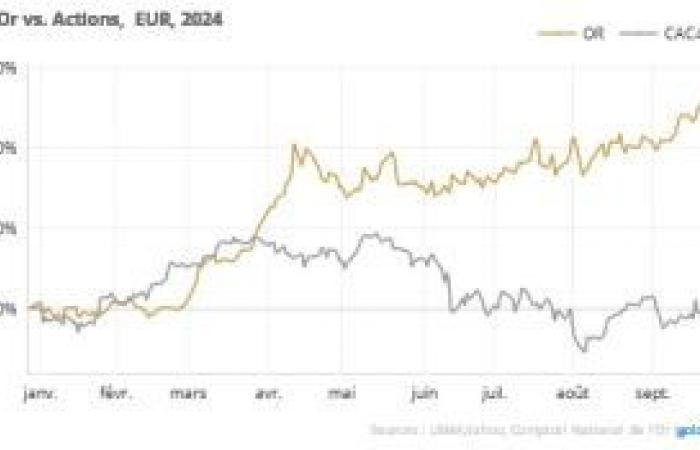In this monthly letter, you will find an update on the performance of gold as well as several news and analyzes on subjects that influence the price of the yellow metal.
What to remember from the past month
- Performance at the end of September: +3.8% over the month, +25% since the start of the year.
- Still around 2% increase at the beginning of October.
- New historic records in euros and dollars, driven by falling rates and geopolitical risk
- Gold remains the best protection against geopolitical risk
- The high price pushes forecasts upwards but weighs on demand
- Central banks: gold becomes the 2th reserve asset, ahead of the euro
Records, again and again
The upward trend continued in September, with new highs for the price of gold. The ounce increased by 3.8% over the month to reach 2,355 euros at the second London fixing on September 30. This brings the 2024 performance to more than 25% for the European investor.
The records were reached on September 26, with daytime levels exceeding $2,680. In euros, a new intraday record was reached on October 4, at 2,430 euros per ounce.
The yellow metal does much better than the CAC40 which remained in balance in September (+0.06%). Same observation for 2024 since the Parisian index only appreciated by 1.3%. You have to go back to 2010 to find such a performance gap : that year the yellow metal appreciated by 37.7%, and the CAC fell by 2.2%.
If bonds benefit from the current drop in interest rates, their performance in 2024 also remains well below, around 2.5%. Real estate is doing better than bonds, but also remains far from the yellow metal.
The price driven by rate cuts
In September, key rate cuts supported the price of the yellow metal which generally benefits from a more accommodating monetary policy.
As anticipated, on September 12 the European Central Bank announced its second rate cut, against a backdrop of inflation being normalized. This stood at 1.2% in France in September, driven by the fall in energy prices. In Germany, activity is not recovering and a recession is now anticipated for 2024 across the Rhine, which should encourage the central bankers of the old continent to further relax monetary policy in the months to come.
The American Federal Reserve announced a 0.5% cut in its rates on September 18, and signaled other possible cuts by the end of the year. Inflation is also on the way to normalization across the Atlantic, with an expected level of 2.1% in 2025.
Gold best protection against geopolitical risk
On the international front, it is the Middle East issue which maintains global uncertainty. The extension of the conflict in Lebanon via Hezbollah, the firing of more than 200 Iranian missiles towards Israel and the uncertainty over the nature and extent of the probable response against the Iranian regime have brought the region into a new unknown. Geopolitics therefore influences the price of gold more than ever.
The effectiveness of gold as a safe haven during geopolitical shocks was analyzed in a May 2024 study, published by JP Morgan Private Banking and entitled “How do geopolitical shocks impact markets?” “. Analysts have dissected 36 major geopolitical events between 1940 and 2022, including among others the German invasion of France in 1940, Pearl Harbor, the Cuban Missile Crisis, the assassination of JFK, the Gulf Wars, the attacks of 11 September 2001, until the invasion of Ukraine. The note concludes that “gold is one of the best tactical hedges we know against geopolitical risk “. Specifically, the researchers noted that the yellow metal tends to appreciate during the 4 weeks preceding and including a major geopolitical event, unlike almost all other asset classes.
What is the impact of high gold prices?
The high prices of the yellow metal and the records, which arrive more quickly than expected, push many analysts to revise their forecasts upwards. Goldman Sachs reiterated its positive view on the yellow metal, but is now considering a price of $2,900 per ounce at the start of 2025, an upward revision of $200. The bank points to the support offered by “lower rates, structurally robust demand from central banks, and the benefits of gold as a safe haven against geopolitical, financial, and recession risks.” In the same vein, the banks ANZ, Macquarie, UBS and Citigroup are considering highs around $3,000 per ounce.
A question mark though: some signs suggest a slowdown in physical demandin particular by the end consumer. In August, Chinese imports from Switzerland stopped for the first time in 3 and a half years, and representatives of the Indian jewelry industry noted a significant drop in jewelry demand due to prices. Something to watch out for in the coming months.
Central banks hold more gold reserves than euros
Purchases of the yellow metal by central banks continue, even if the pace is slowing. In August, the central banks of Poland, Turkey, India and the Czech Republic increased their reserves. In September, the central bank of Hungary announced that it had increased its reserves by 15.5 tonnes, bringing them to 110 tonnes.
These regular purchases of gold by central banks, coupled with the rise in prices, leads to a logical phenomenon: the increase in the proportion of gold in the foreign exchange reserves of central banks. So much so that the yellow metal has become the second reserve “currency” ahead of the euro. More than 16% of global foreign exchange reserves are in yellow metal according to the Bank of America. If the dollar remains the reference asset, its weight is falling significantly under the effect of dedollarization policies initiated by Eastern countries.
Warning :
The price of gold can vary significantly up or down. The information contained in this document does not constitute an investment recommendation and the reader is invited to seek advice from professionals for the management of their savings.

Back








